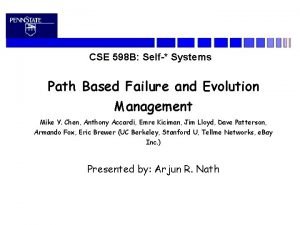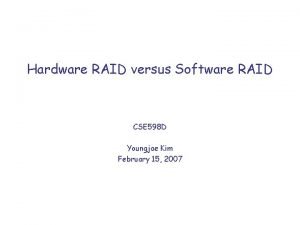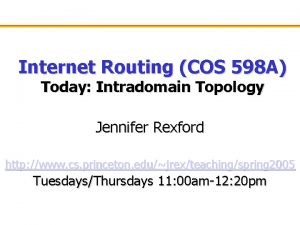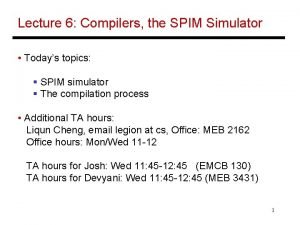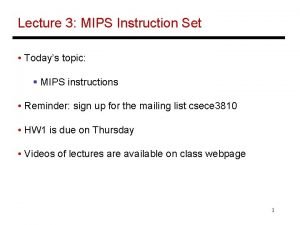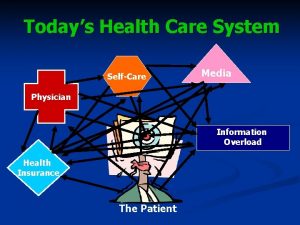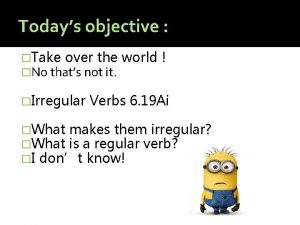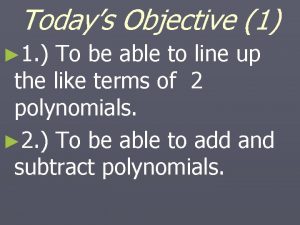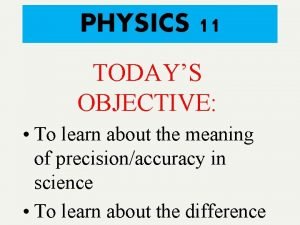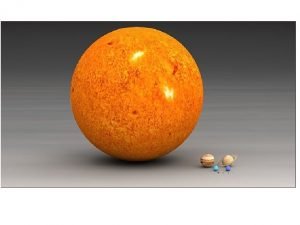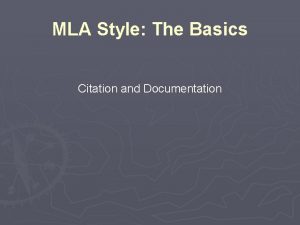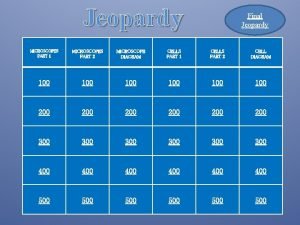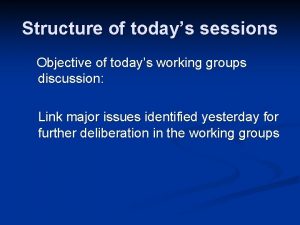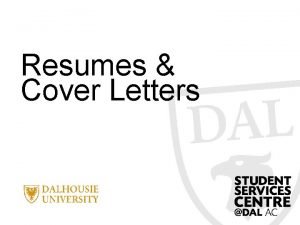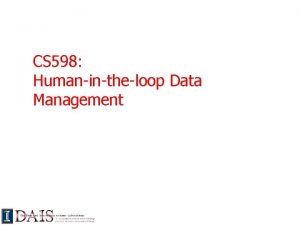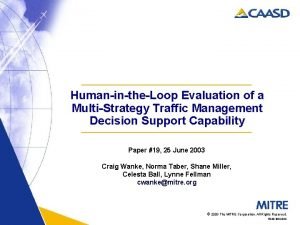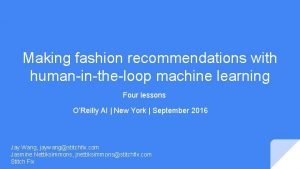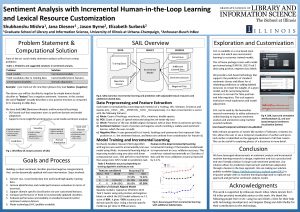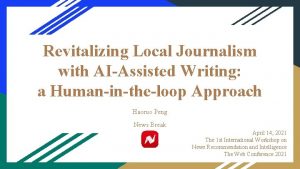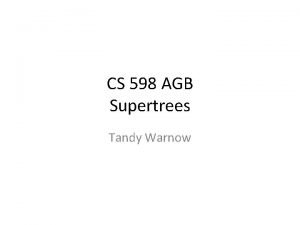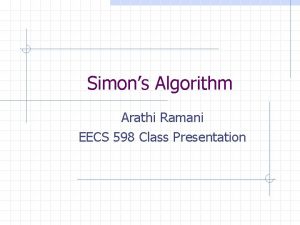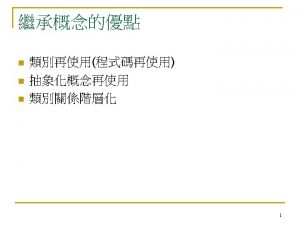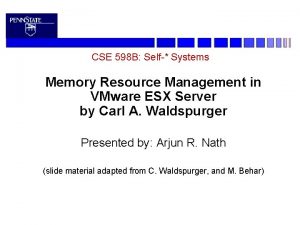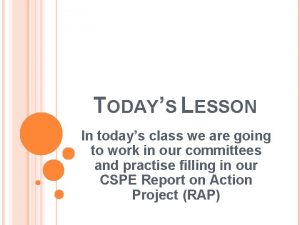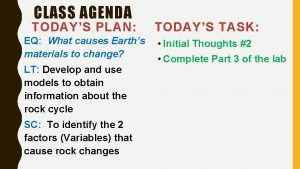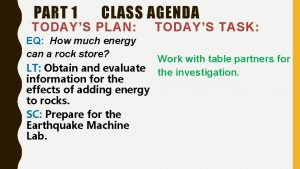CS 598 Humanintheloop Data Management Todays class n









































- Slides: 41

CS 598: Human-in-the-loop Data Management

Today’s class n n n The essentials Bird’s eye view of the class material Getting to know you

The Essentials n n n Instructor: Aditya Parameswaran Office: 2114 SC Email: adityagp@illinois. edu. q q n Meeting Slots: q n Mention “CS 598” in email title I get a LOT of email – do so if you want a response! M/W 9. 30 -10. 45 at 1103 SC Office Hours: q M 10. 45 -11. 30 (or on demand)

The Essentials n TA: Tarique Siddiqui q Email: tsiddiq 2@illinois. edu n q n Mention “CS 598” in email title OH: Fri 9 -10 AM Website: q http: //cs 598. github. io

The Essentials n Prerequisites: q q Basic algorithms and probability A database course of some form n At a high level, you should be familiar with topics such as (or be willing to pick them up) q q n Relational algebra and SQL Semi-structured data Query processing and optimization Data warehousing and data cubes I am happy to have people from different backgrounds… q q But talk to me if you’re not sure MCS or MS/Ph. D in a different field – talk to me.

What sort of a course is this? n n n This is a research-oriented course Very much a “take what you want” q You will not be tested (exams, assignments) or taught (lectures) traditionally: not my job! q Instead, you will engage in research n Read, comment on, and discuss papers q I won’t be teaching: we will discuss together n Pursue a research project That said: this is not an easy course! n The research project requires dedication and ingenuity + dealing with unpredictable outcomes n If you haven’t done research at all before, talk to me!

Course Objectives n Learning advanced database topics q Focusing on an important sub-area: n n n Data processing and management OF/FOR/BY humans q i. e. , emphasizing the human element Especially important in the age of “data science” Learn how to critically evaluate papers Present research Do novel, ~publishable research

Grading n Class Reviews: 20% q n n Class Participation: 15% Paper Presentation: 15% q n due day before class at midnight. Starts on 13 th Sep Send us top 5 papers you’d like to present tonight Research Project: 50% q Proposal (25 th Sep) + report + presentation I will grade on an absolute scale rather than on a curve. n All of you could get A’s! n Emphasis is on learning collectively than *test* you n If your project is truly amazing, you get an automatic A

Class Reviews n n n Since there are no textbooks or exams, I need to be convinced that you’re learning. By Sunday/Tuesday at midnight, submit a review of the paper to be discussed on Monday/Wednesday. Review (up to 500 words – shorter is fine) n n n What is it about? Why is it significant? Key technical contributions relative to previous work Key limitations of technique(s) or unsolved issues Key discussion questions for class First time you will do this: Tuesday Sept 12. n We will send out instructions by tonight.

Class Reviews: Grading n 20% of your grade q q n “Lightly graded”: we will check if you’ve indeed read the paper and identified something not superficial Not a heavy emphasis on testing We will let you skip 3 of the papers covered q q You decide which ones: no penalty Every additional paper you miss beyond the 3 results in an automatic 1/20 drop n n q Want to make sure you’re reading for active discussion We may allow you to make this up by presenting … No late submissions accepted!

Class Participation n n 15% of your grade Classes will be divided into two parts, sometimes interspersed q q n For the discussion part, I will initiate an open-ended debate on the paper q q What could the authors have done better? What they did they do well? (be prepared with your questions about the paper) Participating in the discussion is essential! q n Paper presentation (driven by a student/me) Discussion (driven by me)

Paper Presentation n n 15% of your grade Decide by tonight midnight which papers you’d be interested in presenting q q q Any paper from the reading list (preferably) or others in space Link up on website Also send us any constraints as to days you cannot present (be reasonable!)

Paper Presentation n 30 -40 minute presentation should have 30 ish slides Before preparing, understand paper + background; may need to read related papers! Cover all “key” aspects of paper q q n What is the paper about? Give necessary background Why is it important? Why is it different from prior work? Explain key technical ideas; show they work As few formulae and definitions as possible! Use examples & intuition instead! The presentation slides should be mailed to Tarique 48 hrs prior to your presentation

Paper Presentation: Caveats n Depending on how registration goes… q q We may double up some of you with shorter presentations (15 -20 minutes as opposed to 30 -40) We’ll keep you posted

Research/Implementation Project n n 50% of your grade Build/design/test something new and cool! q Should be “original”, e. g. , reimplementing n n an algorithm from a paper a tool that already exists is not sufficient n n The goal: having something publishable-ish at a Database/Data Mining/Systems conference Amaze us (of course, we will help)

Research/Implementation Project: Requirements n Spectrum of contributions: Contribution can be q Mainly algorithmic, n q Mainly the tool or a component of a tool, n q n with a simple prototype with simple algorithms A mixture of both So, even if you design an algorithm, you need to implement + get your hands dirty q This is typically required at database conferences

Research/Implementation Project: Requirements n If your main contribution is a tool/component: q q n The emphasis is not the UI, and instead the data analytics task Demonstrate: novelty, scalability/efficiency, usability If your main contribution is an algorithm: q q For a well-studied task or a new task Demonstrate: novelty, proof of correctness + scalability/efficiency

Research/Implementation Project: Requirements n Phases: q Week 3: Identify problem n q Week 6: Explore related work/related tools n n n q q q Consult us when you’re picking this – we can help! We need to be convinced that this is new Learn how to position relative to state-of-the-art Starting digging into tools (if they exist) Week 9: Prototype techniques and algorithms Week 12: Build tool/Implement/Test Week 14: Write “paper”

Research/Implementation Project: Spectrum of Options n This could be: q q q A tool to automatically detects data errors or violations A scatter-plot tool that scales to 10 M datapoints A new approximate query processing system based on operating on models instead of data A new algorithm for human-supervised categorization Extending an existing algorithm to handle a new setting or domain <insert your domain specific tool, especially encouraged!>

Research/Implementation Project n n We are happy to provide suggestions… But ideally we would like you to pick projects that you are already working on that could use techniques from this class, or problems that you’re passionate about. The most successful projects from this class have led to HCOMP, KDD, and VLDB papers! If you’d like, we can partner you up with a Ph. D student from our group…

Research/Implementation Project n n n Implement a novel component of Zenvisage, our effortless visualization tool Code up a parser/optimizer for a versioning query language in our versioning tool, Orpheus Adapt our declarative machine learning tool, Gestalt, to allow for automatic feature selection Build a merging tool that allows users to merge two datasets into one by showcasing differences Analyze a large dataset of tasks from a crowdsourcing marketplace to provide task recommendations / search Design a perspective-aware crowdsourced clustering scheme

Research/Implementation Projects n Project team sizes q q n 1 or 2 If you go with 2, then we need to be convinced that you did ~twice as much work You’ll meet us at three points q q q By week 3: deciding the project (PROPOSAL) By week 8: presenting the preliminary outline of how the project will shape up (PRELIMINARY) By week 14: final project report and presentation to class (FINAL REPORT)

Questions about the Class Essentials?

What is the course all about? You may have taken CS 411 and/or CS 511 n. Emphasis on Data Why the fuss about humans? n. Humans are the ones analyzing data n. Reasoning about them “in the loop” of data analysis is crucial n. Traditional DB research ignores the human aspects!

Why is this important now? Up to a million additional analysts will be needed to address data analytics needs in 2018 in the US alone. --- Mc. Kinsey Big Data Report, 2013 -4 n n n But right now, databases are rarely used for data analytics (or “data science”) by small-scale analysts Most analysts use a combination of files + scripts + excel + python + R Discussion Question: Why is that?

Why do databases fare poorly in “data science”? n n n n n Hard to use Hard to learn Does not scale Not easy to do quick and dirty data analysis Does not deal well with ill-formatted or noisy data Does not deal well with unstructured data Hard to keep versions and copies of data Loading times are high Cannot do machine learning or data analysis easily

Themes of the Course: Fixing these issues!! 1. Dealing with Unstructured Data: 1. 2. Dealing with Noisy Data: 1. 3. Data Cleaning tools Dealing with Huge Data: 1. 2. 4. Crowd Powered Systems / Algorithms Scalable Analytics Tools Approximations Dealing with Novice Analysts: 1. New Data Analytics Interfaces Dealing with New Data Analytics Cases: 5. 1. Machine Learning/Graph Systems

What is this course not about? n Distributed or parallel data management q n n n But we will cover it peripherally Cloud computing Transaction processing, recoverability, … Deep discussion of HCI aspects q But we will cover it peripherally

Part 1: Dealing with Unstructured Data n Images, Videos and Raw Text (80% of all data!!!) n Machine Learning Algorithms are not yet powerful q n E. g. , content moderation, training data generation, spam detection, search relevance, … So, we need to use humans, or crowds to generate training data

Crowdsourcing

Crowd “Marketplaces” Can instead get • Comparisons • Pick odd man out • Rate • Pick best out of • Rank Requester: Aditya Reward: 5¢ day Is this. Isanthis image a student an ofimage of astudying? student studying? Yes No Time: 1

Example n n n I want to sort 1000 photos using humans How would I do it? One strategy: ask one human to sort all 1000 Why bad? What else can we do?

Why is using humans to process data problematic? n Humans cost money Humans take time Humans make mistakes n Also, other issues n n q q We don’t know what tasks humans are good at We don’t know how they are trying to game the system We don’t know whether they are distracted We don’t know whether the task is hard or whether they are poor workers

Part 2: Dealing with Noisy Data n n Extracting structure from noisy and semi-structured data can be very hard to do without human help We will study tools to let us extract value from noisy data (or even excel spreadsheets, webpages) easily

Part 3: Dealing with Huge Data n n How can we get results quickly? ? First main technique: Use approximations q Two ways of using approximations n Use “precomputed” samples, sketches or histograms

Part 3: Dealing with Huge Data (Contd. ) n First main technique: Use approximations q Two ways of using approximations n n n Use “precomputed” samples, sketches or histograms Do “online” query processing and termination Second main technique: Leverage main-memory analytics q q Disk is very slow; memory is the new disk Can we do all our processing in main memory?

Part 4: Dealing with Novice Analysts n Gestural Interfaces:

Part 4: Dealing with Novice Analysts n SQL Query Suggestion

Part 5: Dealing with New Use Cases n Machine learning

All about you n Introduce yourself; which department/program you’re in; and your goals from this course

Any other questions?
 In today's class
In today's class Todays class
Todays class Todays class com
Todays class com Hundred thousand place
Hundred thousand place 427 266 to the nearest ten thousand
427 266 to the nearest ten thousand Cse 598 advanced software analysis and design
Cse 598 advanced software analysis and design Evaluate the given postfix expression 6523+8*+3+*
Evaluate the given postfix expression 6523+8*+3+* Cse 598
Cse 598 598 kpc
598 kpc Cse 598
Cse 598 Cse 598
Cse 598 Ixp-598
Ixp-598 Generations
Generations Todays with apostrophe
Todays with apostrophe Todays worldld
Todays worldld Whats todays temperature
Whats todays temperature Todays globl
Todays globl Whats todays wordlw
Whats todays wordlw Chapter 13 marketing in today's world answer key
Chapter 13 marketing in today's world answer key Todays plan
Todays plan Todays sabbath lesson
Todays sabbath lesson Sabbath school welcome
Sabbath school welcome Veseyans rfc
Veseyans rfc Todays health
Todays health Today's objective
Today's objective No thats not it
No thats not it Todays objective
Todays objective Todays whether
Todays whether Todays vision
Todays vision Todays objective
Todays objective Planetarypositionstoday
Planetarypositionstoday Mla cover page
Mla cover page Todays final jeopardy question
Todays final jeopardy question Handcuffing positions
Handcuffing positions Todays weather hull
Todays weather hull Todays objective
Todays objective Date frui
Date frui Todays objective
Todays objective Define todays
Define todays Todays objective
Todays objective Safe online talk
Safe online talk Sample of objective in resume
Sample of objective in resume





